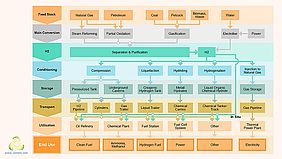Hydrogen is a very useful commodity as it can be used to produce agricultural fertilisers on an industrial scale as well as in fuel cells for transportation and power storage. Nowadays, most hydrogen is generated by means of Steam Methane Reforming (SMR), which has the drawback of releasing CO2 as a by-product. As the use of hydrogen is likely to increase even further until 2100, low-emission processes are needed to satisfy growing demands. Converting methane by means of pyrolysis might be a suitable alternative, where methane is split directly into carbon and hydrogen in a process called cracking. During pyrolysis, a gas or liquid is cycled over a solid catalyst under high pressure and temperature in a closed vessel. The following chemical reaction converts the basic properties of the material into other valuable fuels and products.
Now (2021), scientists at Pacific Northwest National Laboratory (PNNL) and West Virginia University (WVU), together with industry partners such as Southern California Gas Company (SoCalGas) and C4-MCP, have developed a process for the conversion of methane into hydrogen without emitting CO2. A few years ago, scientists at PNNL discovered a nickel-based catalyst formulation that remained secured to its support structure during growth of carbon nanocrystals. This particular property enabled simple recovery of pure carbon nanotubes (CNT) and nanofibers, as well as easy catalyst regeneration. It was these findings the scientists relied on to plan the course of their research. First, they carried out advanced catalyst tests and thoroughly analysed the resulting carbon products. They found that to get the desired growth type, catalyst improvements were needed, which they achieved through systematic testing of nickel particles of different sizes combined with other metals. Adding a second metal was observed to change the mechanism of carbon growth and improve catalyst stability. With the help of a transmission electron microscope, the internal structure and texture of the fresh catalysts, spent catalysts, and the carbon products were characterised. Then, the scientists designed and applied a thermocatalytic decomposition (TCD) method to separate and resynthesize the catalyst for a closed loop process. In the TCD process, methane gas was flowed through a patent-pending bimetallic catalyst in a reactor vessel operating at a temperature of approximately 600oC. The final product of this reaction was hydrogen; solid carbon, meanwhile, accumulated on the catalyst. After that, the catalyst precursors were re-synthesized using some of the carbon product as the catalyst support. Finally, the recycled catalyst was re-used in the reaction, completing the cycle for continuous catalyst replacement. Thorough testing proved that through five TCD cycles, lasting three hours each, the bimetallic catalyst was able to retain reactivity and selectivity for producing both hydrogen and high-value solid carbon co-products. In this process, a potential decrease in carbon dioxide emissions by at least 85 percent was estimated, if a suitable heating process was applied. This could be achieved by burning some of the hydrogen produced, for example, which would even result in zero emissions.The next phase of the project involves installing a pilot-scale demonstration in a fluidized bed reactor where the spent catalyst and carbon products could be removed continuously.
For many years scientists have concentrated their efforts on developing more sustainable fuels and energy systems from hydrogen. In 2015, for example, scientists at the Institute for Advanced Sustainability Studies (IASS) in Potsdam and the Karlsruhe Institute of Technology (KIT) researched an innovative technique to extract hydrogen from methane in a clean and efficient way. They built an experimental reactor that would demonstrate the potential of methane cracking and overcome previous obstacles. The reactor design was completely new and based on a liquid metal technology. In this reactor, tiny methane bubbles were injected at the bottom of a column filled with molten tin. The cracking reaction took place after these bubbles had risen to the surface of the liquid metal. Carbon was separated from the surface of the bubbles and deposited as a powder at the top of the reactor when the bubbles disintegrated.
Scientists at the MIT’s Carbon Capture, Utilization, and Storage Centre now are drawing on this earlier German research and have started a project (2021) to further advance the technologies for producing hydrogen through pyrolysis, after receiving a $750,000 research grant. The team also intends to use molten tin in a reactor, as it can prevent it from blocking up with carbon. So far, equipment for the flow and containment of liquid metal at extreme temperatures without leakage or material degradation have been developed. In the course of pyrolysis, valuable solid carbon will be produced as well as by-product, which will allow the low-carbon tin technology to become economically viable.
There are many advantages to using pyrolysis for hydrogen production: if the technology can be successfully implemented in large-scale applications as well as the production cost offset through sales of carbon co-products, fuel-cell powered vehicles as well as carbon-free microgrids could experience a sustainable boost; the scientists estimated that the crystalline carbon co-products had good market opportunities due to their electrical conductivity, high tensile strength, and high thermal and chemical stability; carbon nanotubes produced through TCD are projected to reduce the prevailing market price by over 75 percent, which facilitates much more rapid prototyping and customer acceptance.
The new method of producing hydrogen could help reduce greenhouse gas emissions worldwide, as it does not only enhance sustainable microgrid energy storage solutions, but also helps to replace petroleum-powered vehicles by low or zero-emission ones. In the long run, this will benefit human health and protect the environment.
